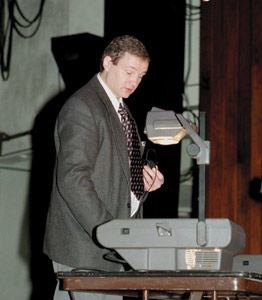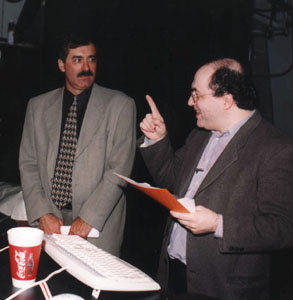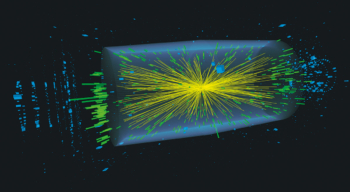Advances in physics go hand in hand with those in experimental techniques, and increasingly so with progress in computing and analysis. A recent workshop at Fermilab surveyed this fast-developing area, which has impact far beyond physics alone.

Fermilab director Mike Witherell, welcoming nearly 200 participants from around the world to the 7th International Workshop on Advanced Computing and Analysis Techniques in Physics Research (ACAT 2000), said: “We have wonderful opportunities awaiting particle physics over the next decade. Two technologies are widely recognized as having driven our field from the beginning – accelerators and particle detectors. But there is also growing recognition that we rely on developments in advanced computing technologies. Innovative scientists often recognize the need for a revolutionary development before the wider world understands what it is good for. Once something becomes available, of course, lots of people know what to do with it, as we have learned over the last decade with the World Wide Web. There is a mutual benefit in collaboration between forefront physics research and computing technology. We rely, all over our laboratory (and our community), on continued innovations in the areas being discussed here at this conference.”
Short history

Reflecting the short history of these techniques, the first workshop in the series was held only 11 years ago in Lyon, France, under the name Artificial Intelligence in High Energy and Nuclear Physics, and was organized by Denis Perret-Gallix (LAPP, Annecy). Following this, the workshop was held in Europe every 18 months or so.
The 7th international workshop was the first to be held in the US with the updated name and with expanded scope. It followed four main tracks: artificial intelligence (neural networks and other multivariate analysis methods); innovative software algorithms and tools; symbolic problem solving; and very large-scale computing. It also covered applications in high-energy physics, astrophysics, accelerator physics and nuclear physics.
Besides the plenary, parallel and poster sessions, the workshop included working group and panel discussion sessions focusing on particular topics – uses of C++, large-scale simulations, advanced analysis environments and global computing – which allowed informal presentations and extensive discussion sessions.
The keynote talk, entitled “Information technology: transforming our society and our lives”, was given by Ruzena Bajcsy of the US National Science Foundation. John Moody, a former particle theorist and now professor of computer science and director of the Computer Finance Program at Oregon Graduate Institute, spoke on “Knowledge discovery through machine learning”. Gaston Gonnet from ETH, Institute for Scientific Computation, Zurich, Switzerland, talked about the “Computer algebra system”.

A big attraction early in the workshop was C++ inventor and world-renowned computer scientist Bjarne Stroustrup from AT&T Bell Labs. He gave a featured talk entitled “Speaking C++ as a native” and served as a distinguished panellist in discussions on the “Use of C++ in scientific computing”. His talk explained, by way of several simple but striking examples, how C++ can be used in a much more expressive manner than one commonly finds. Stroustrup, echoing the comments of Mike Witherell, noted that the world is slow to catch on to new ideas. He also emphasized the need for physicists to be involved in the C++ Standards Committees if they wish to influence the further development of that language.

Another distinguished participant and speaker was Stephen Wolfram, creator of the Mathematica software packages and the winner of a McArthur Foundation Fellowship award in 1981 at the age of 22. Early in his career he worked in high-energy physics, cosmology and quantum field theory. For the last couple of decades he has been developing a general theory of complexity.
Wolfram gave a special colloquium describing his perspective on the development of Mathematica and the establishment of Wolfram Research. His talk gave glimpses of his work on “A new kind of science,” which has occupied his attention during the past nine years. Stephen Wolfram has been working on cellular automata and the evolution of complex systems, and he is writing an epic volume (of about 1000 pages) on the subject, which is soon to be published.
New experiments
High-energy physics experiments and analyses took centre stage halfway through the workshop with plenary talks on “Advanced analysis techniques in HEP” by Pushpa Bhat (Fermilab), “Statistical techniques in HEP” by Louis Lyons (Oxford) and “The H1 neural network trigger project” by Chris Kiesling (MPI). These were followed by “Theoretical computations in electroweak theory” by Georg Weiglein (CERN).
There were vigorous and stimulating discussions in a panel session on Advanced Analysis Environments, with perspectives presented by Rene Brun (CERN), Tony Johnson(SLAC) and Lassi Tuura (CERN and Northeastern).
Fermilab is facing the collider Run II (which began in March) with upgraded CDF and D0 detectors. The advanced computing and analysis techniques discussed at this workshop may be crucial for making major discoveries at the Tevatron experiments.
The new generation of experiments under construction in particle physics, cosmology and astrophysics – CMS and ATLAS at CERN’s LHC collider, the Laser Interferometer Gravitational Observatory (LIGO) and the Sloan Digital Sky Survey (SDSS) – will usher in the most comprehensive programme of study ever attempted of the four fundamental forces of nature and the structure of the universe.
The LHC experiments will probe the tera-electronvolt frontier of particle energies to search for new phenomena and improve our understanding of the nature of mass. LIGO hopes eventually to detect and analyse gravitational waves arising from some of nature’s most energetic events. SDSS will survey a large fraction of the sky and provide the most comprehensive catalogue of astronomical data ever recorded.
Together, these investigations will involve thousands of scientists from around the world. Mining the scientific treasures from these experiments, over national and intercontinental distances, over the next decade or two, will present new problems in data access, processing and distribution, and remote collaboration on a scale never before encountered in the history of science.
Thus “grid computing” is emerging as one key component of the infrastructure that will connect multiple regional and national computational centres, creating a universal source of pervasive and dependable computing power. Grid computing was therefore the focus for a whole day at the workshop. Various champions of the grid projects GriPhyN, Particle Physics Data Grid (PPDG) and European DataGrid contributed, such as Ian Foster (ANL), Paul Avery (Florida), Harvey Newman (Caltech), Miron Livny (Wisconsin), Luciano Barone (INFN) and Fabrizio Gagliardi (CERN), along with other pioneers of grid and worldwide computing.
In the sphere of very-large-scale computing and simulations, Robert Ryne (Los Alamos) spoke on accelerator physics, Alex Szalay (John Hopkins) on astrophysics, Paul Mackenzie (Fermilab) on lattice calculations and Aiichi Nakano (LSU) on molecular dynamics simulations. A working group on large-scale simulations coordinated by Rajendran Raja (Fermilab) and Rob Rosner (Chicago) featured contributions from particle experiments CDF, D0, CMS and ATLAS, as well as from the muon collider and astrophysics communities.
Technology show
A major event at the workshop was a technology show coordinated by SGI representative Kathy Lawlor, Cisco representative Denis Carroll and Fermilab’s Ruth Pordes, Dane Skow and Betsy Schermerhorn.
The show featured the Reality Center for collaborative visualization, IP streaming video, IP Telephony, wireless LAN by SGI and Cisco, and hardware and application software exhibits from Wolfram Research, Platform Computing, Objectivity, Kuck & Associates Inc and Waterloo Maple.
The meeting was organized and co-chaired by Pushpalatha Bhat of Fermilab, who for more than a decade has been a strong advocate of the use of advanced multivariate analysis methods in high-energy physics, and by Matthias Kasemann, head of Fermilab’s Computing Division.
The workshop was sponsored by Fermilab, the US Department of Energy and the US National Science Foundation; it was co-sponsored by Silicon Graphics and Cisco Systems; and it was endorsed by the American and European Physical Societies.
Further reading
The Web site for the workshop is at http://conferences.fnal.gov/acat2000/. All plenary talks were videostreamed live and can be viewed from the Web page. Presentation slides and papers are also available there. The proceedings of the workshop will be published by the American Institute of Physics.





